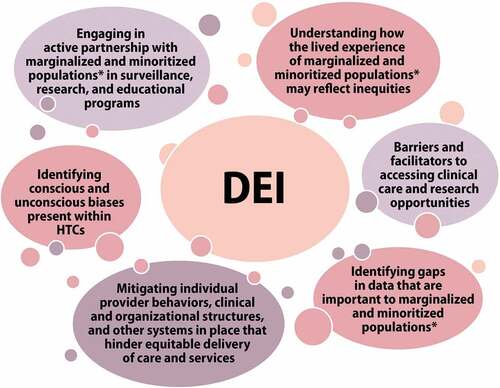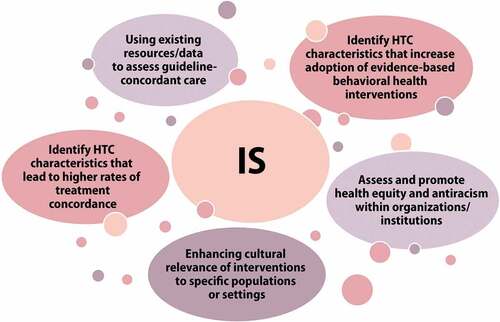Figures & data
Table 1. Components of the Hemophilia Treatment Center and its comprehensive care team [Citation20–23].
Table 2. Six categories of social determinants of health that may impact health outcomes [Citation57,Citation58].
Figure 1. Working Group 5 Diversity, Equity, and Inclusion, Health Services Research, and Implementation Science schematic of community-identified areas for priority research framework *Marginalized and minoritized populations include people who have been traditionally underserved, excluded, and/or oppressed based on a given social standing or some characteristic including but not limited to race, ethnicity, sex, gender identity, sexuality, age, income, disability status, language, culture, faith, geographic location, and country of birth. †[Citation82] BD: bleeding disorder, CDC: (United States) Centers for Disease Control and Prevention, PROM: patient-reported outcome measure, QoL: quality of life, SOC: standard of care, VWD: von Willebrand disease.
![Figure 1. Working Group 5 Diversity, Equity, and Inclusion, Health Services Research, and Implementation Science schematic of community-identified areas for priority research framework *Marginalized and minoritized populations include people who have been traditionally underserved, excluded, and/or oppressed based on a given social standing or some characteristic including but not limited to race, ethnicity, sex, gender identity, sexuality, age, income, disability status, language, culture, faith, geographic location, and country of birth. †[Citation82] BD: bleeding disorder, CDC: (United States) Centers for Disease Control and Prevention, PROM: patient-reported outcome measure, QoL: quality of life, SOC: standard of care, VWD: von Willebrand disease.](/cms/asset/dda902bf-14de-4858-8b47-8a8a3b3745e0/ierr_a_2183836_f0001_c.jpg)
Table 3. Members of Working Group 5.
Table 4. Summary of expert presentations and discussion themes for each WG5 subject work block.
Table 5. Priority research questions in the areas of health services research; diversity, equity, and inclusion; and implementation science.
Figure 2. Priority research themes identified by WG5 in the area of health services research. *Marginalized and minoritized populations include people who have been traditionally underserved, excluded, and/or oppressed based on a given social standing or some characteristic including but not limited to race, ethnicity, sex, gender identity, sexuality, age, income, disability status, language, culture, faith, geographic location, and country of birth. **Behavioral health support services are any service that aims to support mental health, well-being/QoL, pain management, and healthy lifestyles. HSR: health services research, HTC: Hemophilia Treatment Center, QoL: quality of life, WG: working group.

Figure 3. Priority research themes identified by WG5 in the area of diversity, equity, and inclusion. *Marginalized and minoritized populations include people who have been traditionally underserved, excluded, and/or oppressed based on a given social standing or some characteristic including but not limited to race, ethnicity, sex, gender identity, sexuality, age, income, disability status, language, culture, faith, geographic location, and country of birth. DEI: diversity, equity, and inclusion, HTC: Hemophilia Treatment Center, WG: working group.

Figure 4. Priority research themes identified by WG5 in the area of implementation science. HTC: Hemophilia Treatment Center, IS: implementation science, WG: working group.

